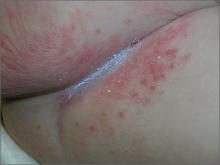The FP diagnosed Candida diaper dermatitis in this patient based on the erythema, white scale, satellite lesions (pustules or papules beyond the rash border), and involvement of the skin folds. The FP also inspected the oropharynx for signs of thrush, but no thrush was detected.
Diaper dermatitis often has a multifactorial etiology. The main cause is irritation of the skin as a result of prolonged contact with moisture, such as feces and urine. Irritant diaper dermatitis is a combination of intertrigo and miliaria (heat rash that occurs when eccrine glands become obstructed from excessive hydration). It is a noninfectious, nonallergic, and often asymptomatic contact dermatitis. Within 3 days, 45% to 75% of diaper rashes are colonized with Candida albicans of fecal origin.
Treatment begins with frequent diaper changes (as soon as the infant is wet or soiled and at least every 3-4 hours), and frequent gentle cleaning of the affected area with lukewarm tap water instead of commercial wipes that contain alcohol. A squeeze bottle with lukewarm water can be used to avoid rubbing the delicate skin. Superabsorbent disposable diapers that pull moisture away from the skin are also helpful.
In addition, barrier preparations, including zinc oxide paste, petroleum jelly, and vitamin A and D ointment are helpful after each diaper change.Pastes are better than ointments, which, in turn, are better than creams or lotions. Caregivers should avoid products with fragrances or preservatives to minimize the chance of an allergic response.
Barrier preparations should be used on top of other indicated therapies. Combination antifungal-steroid agents that contain steroids stronger than hydrocortisone (eg, clotrimazole/betamethasone) should be avoided. Potent topical steroids can cause striae and skin erosions, hypothalamus-pituitary-adrenal axis suppression, and Cushing syndrome.
In this case, the FP recommended the treatment steps outlined above, as well as topical nonprescription antifungal creams (eg, clotrimazole and miconazole) after every diaper change until the rash resolved.
Photo and text for Photo Rounds Friday courtesy of Richard P. Usatine, MD. This case was adapted from: Malit B, Taylor J. Diaper rash and perianal dermatitis. Usatine R, Smith M, Mayeaux EJ, et al, eds. Color Atlas of Family Medicine. 2nd ed. New York, NY: McGraw-Hill; 2013:646-650.
To learn more about the Color Atlas of Family Medicine, see: www.amazon.com/Color-Family-Medicine-Richard-Usatine/dp/0071769641/
You can now get the second edition of the Color Atlas of Family Medicine as an app by clicking on this link: usatinemedia.com


